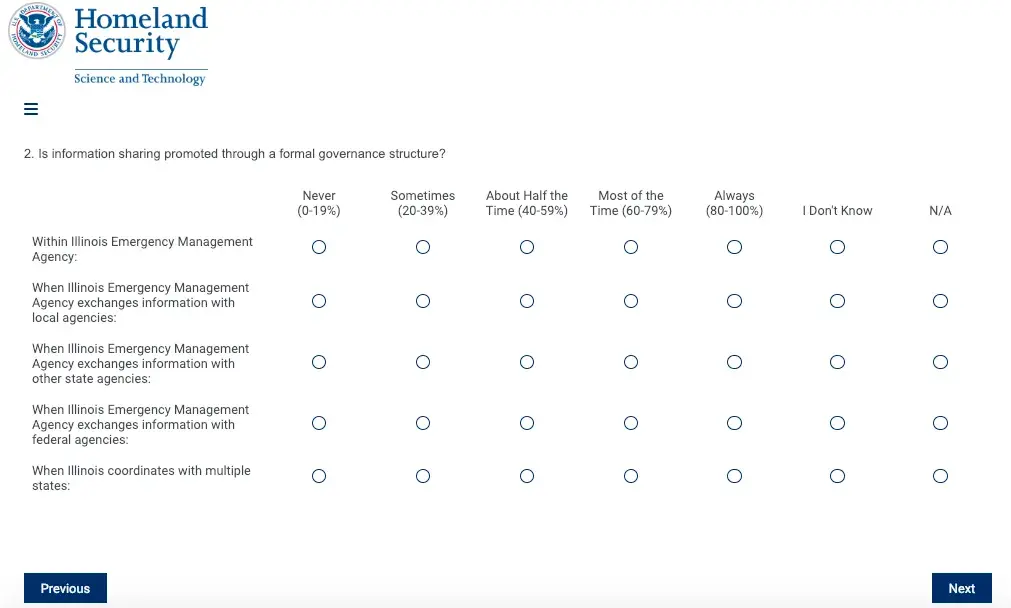Information is key in times of crisis. Public safety and emergency management agencies need fast, reliable data to help them make the best possible decisions, which means dependable communication systems can directly lead to saving lives.
When it comes to information sharing, though, it can be difficult to answer the question ‘How do you know what you don’t know?’ Different jurisdictions have different tools and resources available. Best practices vary, and it may not always be clear when capabilities are falling short. That’s why the Department of Homeland Security (DHS) Science and Technology Directorate’s (S&T) Information Sharing Assessment Tool (ISAT) is so valuable.
 Newly updated with optional scenarios and expanded question sets, the ISAT is a web-based self-assessment tool that helps public safety agencies understand their current information sharing capabilities and gaps. The ISAT is voluntary, free, and easy to use. It only takes 15-20 minutes to complete, but this is not your typical online quiz.
Newly updated with optional scenarios and expanded question sets, the ISAT is a web-based self-assessment tool that helps public safety agencies understand their current information sharing capabilities and gaps. The ISAT is voluntary, free, and easy to use. It only takes 15-20 minutes to complete, but this is not your typical online quiz.
“The ISAT is supported by subject matter experts from across the nation representing fire protection, law enforcement, emergency medical services, emergency management, 9-1-1 and information technology,” said ISAT program manager Ronald Langhelm. “They have played an instrumental role in guiding and advising all phases of development to ensure the ISAT is a useful resource for first responders, developed by first responders.”
Public safety practitioners provided crucial guidance to DHS S&T through pilot programs in diverse communities nationwide. Because it is public safety-driven, user feedback is central to the development of the tool—and the ISAT keeps improving. The new expansion includes optional scenarios such as severe weather or active shooter and optional questions that allow users to dive deeper into information sharing issues specific to their needs.
“By taking the ISAT, public safety users can answer the question ‘What should I consider to improve my agency or jurisdiction’s operational information sharing capabilities?’” said Fire Chief Chris Tubbs of the Southern Marin Fire Protection District just north of San Francisco. “The value of ISAT is that it crosses disciplines both horizontally and vertically. As a local agency, we have interactions with local, state, and federal agencies. The ISAT allows us to assess where we have strengths sharing information across these levels of government and where gaps are to take action.” Southern Marin Fire Protection District is one of many local agencies that has piloted ISAT to contribute to its development.
To develop the ISAT, DHS S&T utilized the SAFECOM Interoperability Continuum. This conceptual framework helps agencies plan and implement solutions by highlighting five critical success elements that should be considered when addressing interoperability. Those success elements are: governance, standard operating procedures, technology, training and exercises, and usage of interoperable communications. The ISAT questions are designed to address all these elements.
Though users begin the ISAT by responding to demographics questions, no personally identifiable information is collected. Rather, these responses allow the system to automatically customize the rest of the assessment to the individual user’s agency and jurisdiction.
All users who complete the ISAT receive a customized report that reflects their responses, as well as a list of helpful resources and reference materials such as templates, case-studies, and best practices that can be used to assist in action planning. While the ISAT can be taken by one individual, it can also be taken by many in an organization to gauge the range of awareness levels staff members have when it comes to information sharing plans and tools. The ISAT can also be taken by multiple organizations across a region or state to facilitate broad assessment of information sharing issues and validation of progress.
The results generated by the ISAT help communities identify strengths and weaknesses where local and regional partners can collaborate to find solutions and improve information exchange before, during, and after a disaster. Through macro-level data analysis, the ISAT also helps inform DHS of strategic investment areas to prioritize future research and development efforts, so the entire nation can be more resilient.
The ISAT is available online now. Click here to take the assessment and to pinpoint the most pressing information sharing barriers to your agency’s operations.
